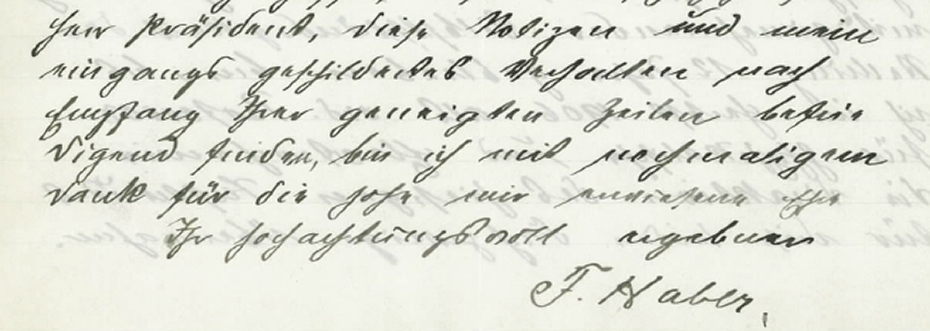Fritz Haber (1868–1934)
Chemist

Fritz Haber was born to Paula and Siegfried Haber, a businessman and proprietor of a trading company for chemicals, on 9 December 1868 in Breslau, where he completed his schooling in 1886.
At the end of the year, he embarked on a degree in chemistry at the Friedrich Wilhelm University of Berlin before switching to the University of Heidelberg in the summer and returning to the Technical University of Berlin, where he completed a doctorate in 1891.
Further education and habilitation
After a series of apprenticeships in chemical factories, he moved to Zurich for a semester to further his education before joining his father's company briefly.
From the winter of 1892, he attended the University of Jena for one and a half years. As of 1894, he worked as an assistant at the Karlsruhe Institute of Technology, qualified as a professor in 1896 and was made an associate professor of physical chemistry in 1898 and a full professor in 1906.
Marriage and Nobel Prize
In 1901 he married Clara Immerwahr, the first woman to obtain a PhD in chemistry in Germany, with whom he had a son the following year.
In 1908 Haber succeeded in synthesising hydrogen and atmospheric nitrogen to form ammonia. Together with Carl Bosch, he used this to develop the world’s most important method for the industrial production of chemical fertilisers, which enabled increased crop yields to supply food to the global population that had been booming since the 19th century. Ten years later, Haber received the external page Nobel Prize for Chemistry for ammonia synthesis.
Success and First World War
In 1911 Fritz Haber was appointed as director of the newly founded Kaiser Wilhelm Institute of Physical Chemistry and Electrochemistry and a full honorary professor at the University of Berlin. From 1914 he conducted research on behalf of the Ministry of War: initially, he organised the increase in ammonia production to make explosives before developing lethal gas warfare and supervising Germany's first chlorine gas attacks in Ypres in 1915. Shortly afterwards, his wife Clara took her own life. In 1917 Haber remarried – a secretary called Charlotte Nathan, by whom he had a daughter and a son over the next few years. The couple eventually divorced in 1927.
After the war, Haber was sought by the Allies as a war criminal for the use of chemical warfare on the grounds that it was in violation of international law.
Escape and Second World War
In order to escape extradition, he fled to Switzerland temporarily. Back in Berlin, he spent a number of years trying to extract the gold from seawater to enable Germany to pay the reparations it owed in accordance with the peace treaty, but to no avail. When the Nazis seized power in 1933 and dismissed the numerous Jewish members of staff at the Kaiser Wilhelm Institute, Haber – who was also of Jewish descent – resigned. In late autumn of that year, he emigrated to England following an invitation from the University of Cambridge. Having been ill for some time, he travelled to Switzerland in early 1934 and died in Basel on 29 January.
Connections with the Federal Polytechnic Institute
In the winter semester of 1891/92, Fritz Haber took a course in technical chemistry with Professor Georg Lunge at the Federal Polytechnic Institute, who also came from Breslau. In 1907 the polytechnic asked him to become Lunge's successor, who had retired, but Haber declined when he was offered better terms of employment in Karlsruhe. When he relocated to Berlin, he had a hand in helping Richard Willstätter, who had been a full professor of chemistry at the Federal Polytechnic Institute since 1905, to join him in the German capital in 1912. Then, while holidaying in Switzerland in January 1913, Haber wrote a letter to an acquaintance at the Prussian Ministry of Education, in which he drafted a detailed plan as to how Albert Einstein, who had also been working at ETH Zurich as a full professor of physics since 1912, could also be lured to Berlin. After Einstein followed the call to Berlin in 1914, Haber even invited his personal assistant, Otto Stern, who had just qualified as a professor at ETH Zurich, to work for him at the Kaiser Wilhelm Institute of Physical Chemistry.
Manuscript

Holdings
Haber's student dossier and the documents for the post he rejected at ETH Zurich are held in the ETH Zurich University Archives.
All Nobel Prize laureates of ETH Zurich at a glance